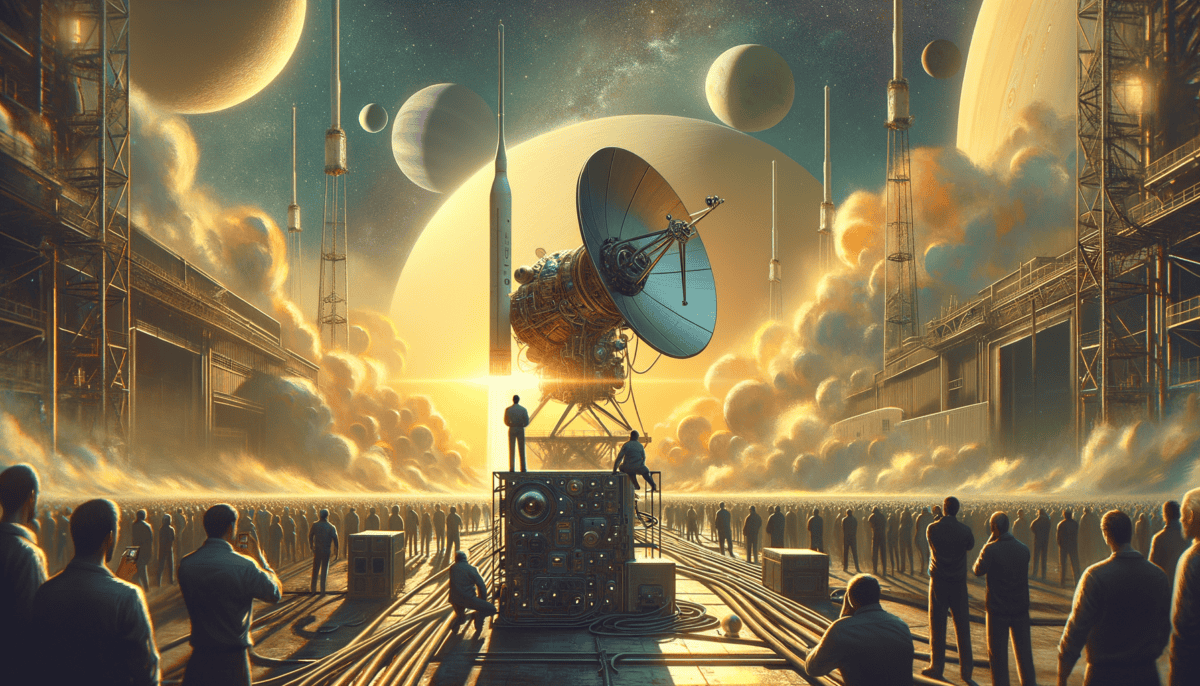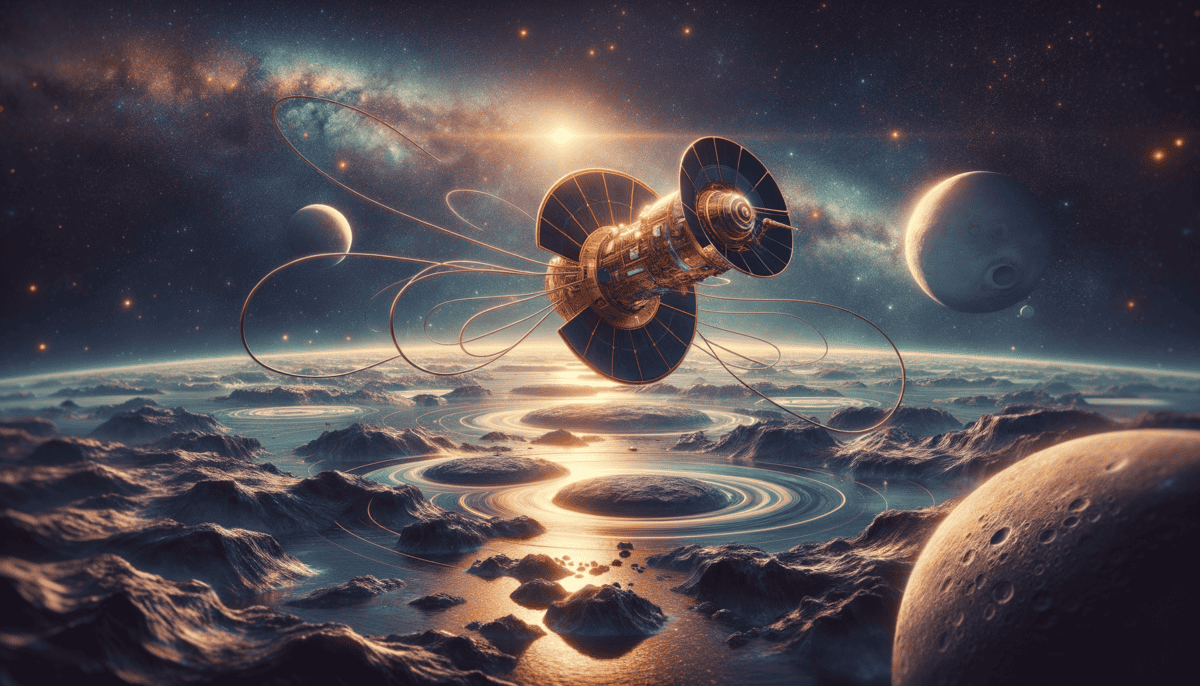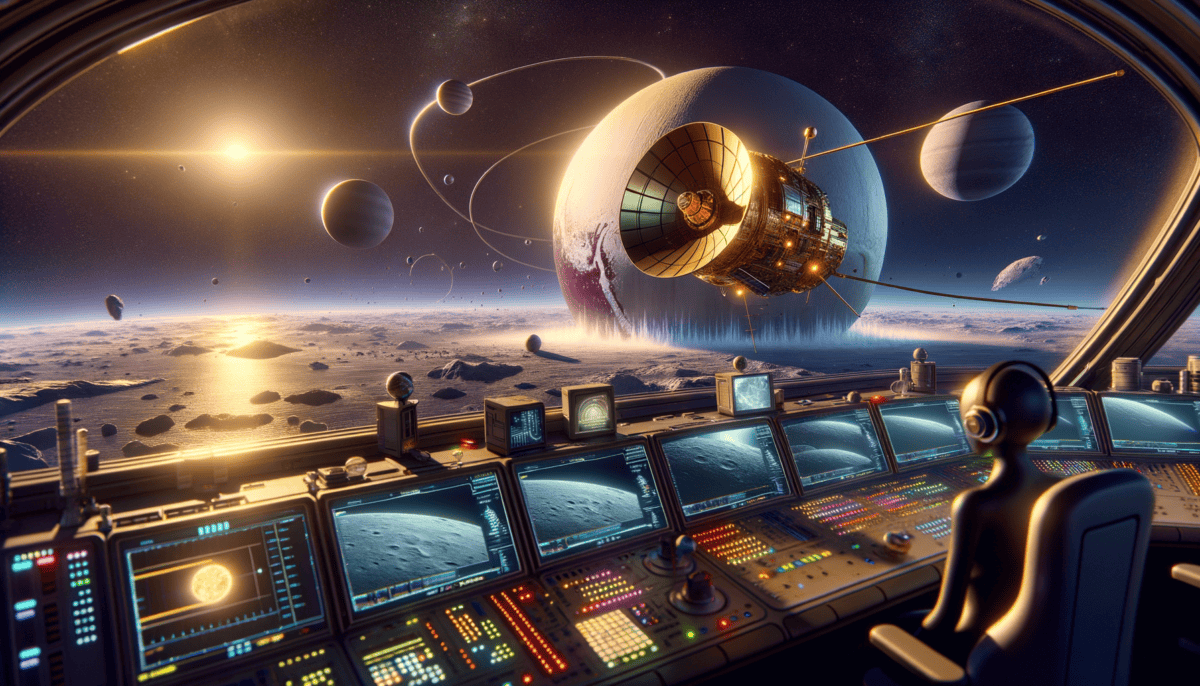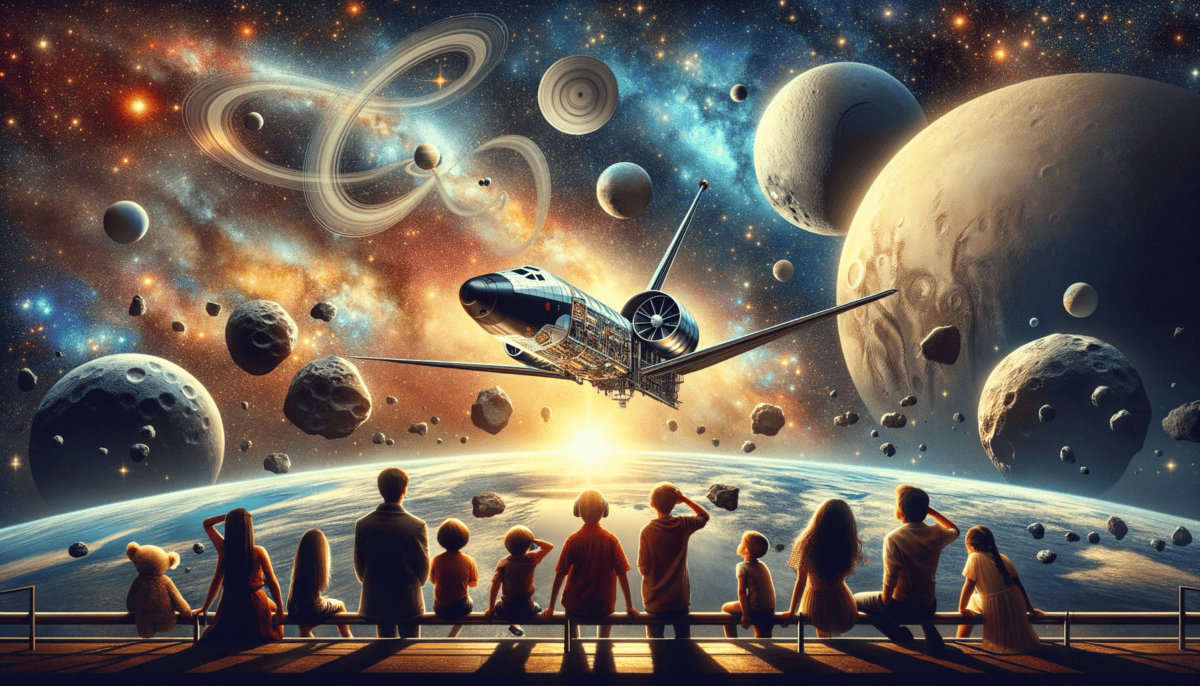Dreaming of the Stars
Dr. Sarah Martinez stared at the giant screen in NASA's mission control room. Her heart was racing. After fifteen years of planning, the New Horizons mission was finally becoming real.
"Can you believe we're actually going to see Pluto up close?" she asked her colleague, Dr. Tom Chen, who was busy checking data on his computer.
"It's like a dream come true," Tom smiled, his eyes twinkling with excitement. "But first, we need to figure out how to get there!"
The Big Idea
Getting to Pluto wasn't easy. It was really far away – about 3 billion miles from Earth! That's like driving around the Earth 120,000 times.
Sarah remembered the day she first shared her wild idea with NASA:
"We can build a small, fast spacecraft," she had told the room full of scientists. "It will zoom past Jupiter, using its gravity like a slingshot to go even faster toward Pluto!"
Some people thought it was impossible. But Sarah and her team knew they had to try. No one had ever seen Pluto up close before!
Building the Dream Team
To make this mission work, they needed the best space scientists and engineers in the world. Here's who joined the team:
• Dr. Sarah Martinez – Mission Leader
• Dr. Tom Chen – Navigation Expert
• Engineer Maria Rodriguez – Spacecraft Designer
• Dr. James Wilson – Camera Systems
• Dr. Emily Thompson – Power Systems
The Money Problem
Building a spacecraft isn't cheap! Sarah and her team had to convince NASA to give them $700 million. That sounds like a lot, but it was actually one of the least expensive missions to the outer solar system.
"Think about what we'll learn!" Sarah told NASA's leaders. "We could find mountains made of ice, or frozen oceans, or things we've never even imagined!"
The NASA leaders looked at each other and nodded. They knew this was their chance to make history.
Getting Ready for Launch
Maria spent months designing the spacecraft. It needed special tools to take pictures and measure things about Pluto. It also needed a power source that would work billions of miles from Earth, where the sun looks like just another star.
"We'll use plutonium for power," Maria explained to the team. "It's like a tiny power plant inside the spacecraft!"
Tom worked on planning the path to Pluto. "We have to be perfect," he said, drawing lines on a star map. "One small mistake and we could miss Pluto completely!"
The Clock is Ticking
As launch day got closer, everyone worked harder than ever. They tested everything again and again. They couldn't make any mistakes – there would be no way to fix the spacecraft once it left Earth.
Sarah looked around at her tired but determined team. They had spent years working on this dream. Soon, they would find out if it would all work.
"Tomorrow, we start final preparations," she announced. "In just a few months, we'll be ready to launch. Get some rest, everyone. We're about to make history!"
The team members gathered their things to head home, but they couldn't stop smiling. They were about to send a spacecraft farther than anyone had ever gone before. The journey to Pluto was about to begin!
Racing to the Stars
The morning of January 19, 2006, was cold and clear at Cape Canaveral. Sarah and her team arrived before sunrise. Today was launch day!
The Final Countdown
"All systems are go!" Maria called out from her station. She had checked the spacecraft one last time.
New Horizons sat on top of a giant rocket, ready for its long journey. The spacecraft looked tiny – like a shiny metal triangle with a long antenna.
• Weight: About 1,000 pounds
• Speed: Fastest spacecraft ever launched
• Distance to travel: 3 billion miles
• Time to reach Pluto: 9.5 years
The Big Moment
Tom watched the countdown clock nervously. "Ten minutes to launch!" he announced.
"Remember everyone," Sarah said through her headset, "we only get one chance at this. Everything must be perfect!"
The whole room fell quiet. They could hear the rocket's engines starting to rumble.
Blast Off!
"5… 4… 3… 2… 1… LIFTOFF!"
The rocket roared to life! Fire and smoke filled the air. New Horizons rose slowly at first, then shot into the sky like an arrow!
"Look at it go!" Emily shouted. "It's the fastest spacecraft ever launched!"
Racing Through Space
New Horizons didn't just go fast – it went SUPER fast! In just 9 hours, it passed the moon. It took other spacecraft days to do that!
"We're going about 36,000 miles per hour," Tom explained. "That's like flying from New York to Los Angeles in 5 minutes!"
First Challenge
But then, something worried the team. One of the spacecraft's instruments wasn't working right.
"Don't panic," Maria said calmly. "We planned for this."
The team worked together to fix the problem by sending special commands to the spacecraft. After a few tense hours, everything was working perfectly again!
The Long Journey Begins
As night fell, Sarah looked at the tired but happy faces around her. New Horizons was safely on its way to Pluto.
"Good job, everyone," she said with a big smile. "But this is just the beginning. We have nine years of flying through space ahead of us!"
The spacecraft was now zooming past Mars' orbit, heading toward Jupiter. It would need to use Jupiter's gravity like a giant slingshot to go even faster toward Pluto.
As the team celebrated their successful launch, they knew the real adventure was just beginning. New Horizons had a long way to go, and many more challenges to face in the vast darkness of space.
Through the big windows of mission control, they could see the stars twinkling in the night sky. Somewhere out there, their tiny spacecraft was racing toward history.
The Cosmic Slingshot
After thirteen months of speeding through space, New Horizons approached Jupiter. The giant planet looked like a huge orange marble through the spacecraft’s cameras.
The Big Swing
“Today’s the day!” Sarah announced to her team. “Jupiter will help us go even faster!”
Tom scratched his head. “But how can Jupiter make us go faster?”
“Think of it like a game of catch,” Maria explained. “Jupiter’s gravity will grab New Horizons and swing it around, just like your arm throwing a ball!”
• Distance from Jupiter: 1.4 million miles
• Speed boost: 9,000 miles per hour faster
• Pictures taken: Over 700
• Time near Jupiter: 8 hours
Dodge the Space Rocks!
But getting to Jupiter wasn’t easy. The spacecraft had to fly through fields of asteroids – big space rocks floating in space! ☄️
“Look out!” Emily pointed at her screen. “There’s a whole bunch of rocks ahead!”
The team carefully guided New Horizons through the asteroid field. It was like playing the world’s biggest video game, but they couldn’t make any mistakes!
Talking to Home
As New Horizons got further from Earth, sending messages became harder. It was like trying to whisper to someone across a huge playground!
“Each message now takes over an hour to reach the spacecraft,” Sarah explained. “And another hour to get back to us.”
Keeping the Lights On
The spacecraft needed power to work, but it was so far from the Sun that its solar panels couldn’t get much energy.
“That’s why we gave it a special battery,” Maria said proudly. “It’s like a tiny power plant that will work for years and years!”
Pictures from Far Away
New Horizons sent back amazing photos of Jupiter. It saw giant storms, colorful clouds, and even Jupiter’s moons!
“Look at this!” Tom showed everyone a picture of Jupiter’s famous Great Red Spot – a storm bigger than Earth that’s been spinning for hundreds of years.
The Big Push
Finally, the big moment arrived. New Horizons zoomed past Jupiter, using its gravity like a cosmic slingshot. The spacecraft was now going faster than any spacecraft had ever gone before!
“We did it!” Sarah cheered. “Now we’re really on our way to Pluto!”
The team watched their monitors as New Horizons sped away from Jupiter, racing deeper into the dark outer solar system. The tiny spacecraft was now heading toward places no one had ever seen up close.
Outside mission control, night was falling. The stars seemed to twinkle a little brighter, as if they were winking at humanity’s latest adventure into the unknown. ✨
First Light on a Hidden World
At Mission Control, Sarah peered at her screen with wide eyes. After nine long years of travel, New Horizons was finally getting its first real look at Pluto!
A Tiny Dot Grows Bigger
“I can see it!” Tom jumped from his chair. “Pluto’s not just a dot anymore!”
“Every day, our pictures get a little clearer,” Maria smiled. “It’s like watching a flower slowly bloom in space.”
Getting Ready for the Big Show
The spacecraft carried special tools to study Pluto. Each one had an important job:
• RALPH: Takes color pictures
• ALICE: Studies Pluto's air
• REX: Listens for radio signals
• SWAP: Looks at space weather
• PEPSSI: Checks for tiny particles
• LORRI: Takes detailed black and white photos
Excitement Builds
Emily bounced in her chair. “Look at these heart shapes on Pluto’s surface! Nobody knew those were there!”
“And those dark spots,” Tom pointed. “What do you think made them?”
The whole team felt like kids opening presents on Christmas morning. Each new picture showed them something nobody had ever seen before! ⭐
Careful Planning
“Remember everyone,” Sarah called out. “We only get one chance to do this right!”
The team worked day and night to make sure everything was perfect. They checked their math again and again. New Horizons had to fly past Pluto at just the right distance and speed.
A Few Scary Moments
Just weeks before reaching Pluto, the spacecraft suddenly stopped talking to Earth!
“Don’t panic,” Maria told the worried team. “We trained for this.”
After a few nervous hours, they fixed the problem. New Horizons was back on track, zooming toward its date with Pluto.
Getting Close!
As New Horizons got closer, everyone at Mission Control worked harder than ever. They had to program all the spacecraft’s moves perfectly.
“It’s like teaching a robot to dance,” Tom explained to a visitor. “But the dance floor is billions of miles away!”
The pictures kept getting better and better. Pluto was changing from a mysterious dot into a real world with mountains, valleys, and ice plains.
Sarah looked at her team with pride. “Tomorrow’s the big day, everyone. The day we’ve all been waiting for!”
Outside the control room windows, the summer sun was setting. Somewhere in the darkening sky, a tiny spacecraft was racing toward its biggest adventure yet.
Heart of Ice and Wonder
The big moment had finally arrived! New Horizons zoomed past Pluto at super-fast speed. The room was so quiet you could hear a pin drop.
The Perfect Shot
“Look at that!” Sarah gasped, pointing at the screen. “It’s… it’s beautiful!”
“Nine years of travel for this moment,” Tom whispered. “And wow, was it worth it!”
A World of Surprises
The pictures showed things nobody expected to see:
• Ice mountains as tall as the Rocky Mountains! ⛰️
• Smooth plains of frozen nitrogen
• Dark red areas made of strange ice
• Mysterious valleys and cracks
• Thin blue sky layers
• Giant ice volcanoes!
Dancing Moons
“The moons!” Emily called out. “They’re spinning like tops!”
New Horizons saw Pluto’s five moons doing a space dance. The biggest moon, Charon, was half as big as Pluto itself!
Making History
“We did it!” Maria jumped up and down. “We’re the first humans to ever see Pluto up close!”
Everyone in Mission Control hugged and cheered. Some people even cried happy tears.
Shocking Discoveries
“Look at these mountains made of water ice,” Tom pointed. “They’re floating on softer nitrogen ice below!”
Sarah nodded excitedly. “And see those dark spots? They might be ice volcanoes that shoot out frozen water instead of hot lava!”
A Living World
“Pluto isn’t just a frozen ball,” Maria explained to a group of visiting kids. “It’s alive in its own way, always changing and moving!”
The spacecraft took hundreds of pictures as it flew past. Each one showed something new and exciting.
Messages from Far Away
“The data is coming in!” Emily called out. “But it’s going to take months to get all of it!”
Because Pluto was so far away, the pictures and information took a long time to reach Earth. It was like getting mail from the edge of our solar system!
A New Chapter
As the team looked at the amazing pictures, they knew space exploration would never be the same. Pluto wasn’t just a tiny dot anymore – it was a real world with its own special features and mysteries.
“This is just the beginning,” Sarah smiled. “There’s so much more out there to explore!”
New Horizons had done something amazing, but it wasn’t done yet. The little spacecraft was already heading deeper into space, ready for more adventures!
Dreams Beyond the Stars
After its amazing visit to Pluto, New Horizons kept zooming through space. It was heading to places no one had ever seen before!
The Next Adventure
Sarah rushed into Mission Control one morning, waving a picture. “Everyone, look! We found something new!”
“It’s an object in the Kuiper Belt,” Tom explained to the team. “We’re calling it Arrokoth. It looks like a snowman in space!” ☃️
Space Records
New Horizons broke lots of amazing records:
• Fastest spacecraft ever launched from Earth
• First close-up pictures of Pluto
• Farthest space photos ever taken
• Longest-operating space mission to the outer solar system
• First visit to a Kuiper Belt object
Inspiring Young Scientists
“Look at all these letters!” Emily smiled, showing the team mailbags full of cards from kids around the world.
“Dear New Horizons Team,” Maria read from one letter. “I want to be a space scientist when I grow up because of you!”
Teaching the World
Scientists learned so much from New Horizons:
“Pluto is more alive than we thought,” Sarah explained to a class of students on video chat. “It has mountains, valleys, and even weather!”
“And we now know the Kuiper Belt is full of interesting objects,” Tom added. “It’s like a treasure chest at the edge of our solar system!”
Still Going Strong
“Our brave little spacecraft is still healthy,” Emily reported. “It could keep exploring for another 20 years!”
A Forever Journey
The team gathered to celebrate their mission’s success. They looked at a big map showing New Horizons’ path through space.
“It’s heading toward the stars now,” Maria smiled. “Someday, it will leave our solar system completely!”
Looking Back, Looking Forward
“Remember when we first started?” Tom asked. “Some people said we couldn’t do it. But look at everything we’ve learned!”
Sarah nodded. “And there’s still so much more to discover. This is just the beginning of exploring our cosmic neighborhood!”
The Greatest Adventure
New Horizons showed us that space is full of surprises. It taught us to be brave, curious, and never stop exploring.
“What’s the most important thing we learned?” a student asked during a school visit.
Emily smiled. “That when we dream big and work together, we can reach the stars!” ⭐
And somewhere out there, a tiny spacecraft called New Horizons keeps flying, carrying human dreams into the endless frontier of space.






